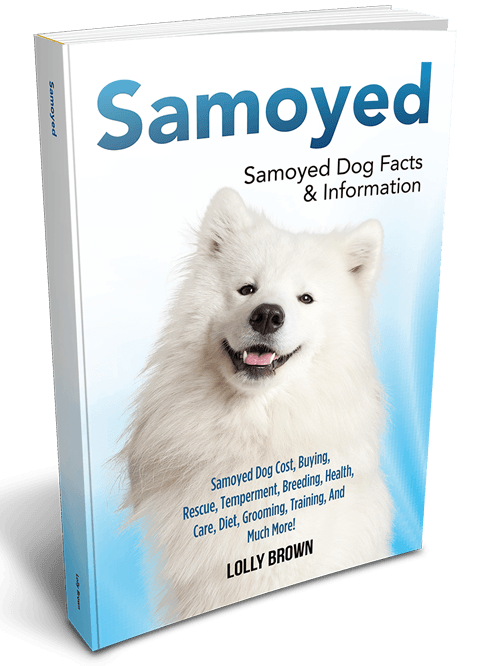CHAPTERS
Navigate to chapter
► Chapter 1: Understanding Samoyeds
► Chapter 2: Things to Know Before Getting a Samoyed
► Chapter 3: Purchasing Samoyed Dogs
► Chapter 4: Caring for Samoyed Dogs
► Chapter 5: Meeting Your Samoyed’s Nutritional Needs
► Chapter 6: Training Your Samoyed
► Chapter 7: Grooming Your Samoyed
► Chapter 8: Breeding Samoyeds
► Chapter 9: Showing Your Samoyed
► Chapter 10: Keeping Your Samoyed Dog Healthy
Chapter 1: Understanding Samoyeds

The first thing that many people notice about the Samoyed breed is its fluffy white coat. While the Samoyed’s coat certainly is beautiful and unique, there are many more qualities to love in this breed. If you really want to determine whether this breed is a good fit for you and your family, you need to take the time to learn as much as you can about these dogs. In this chapter you will receive a general overview of the breed as well as some in-depth facts and information about Samoyeds. You will also receive a breed history to help you get started in familiarizing yourself with the Samoyed dog breed.
If you know anything about other Spitz-type breeds like the Alaskan Malamute and the Siberian Husky, the Samoyed may look a little familiar to you. Most Spitz-type dogs have thick double coats and a plumed tail that they carry high up over their backs. These dogs are adapted to living and working on very cold climates, relying on their wooly undercoats to keep them warm and their longer outer coats to protect them against the elements. The Samoyed is a Spitz-type dog so it has these same qualities among many others which make it unique.
There is no denying that the Samoyed, affectionately nicknamed the Sammy, is one of the most beautiful dog breeds out there. These dogs have a thick, fluffy coat that is pure white in color. These dogs have a wedge-shaped head, pointed ears, and a plumed tail not to mention an intelligent expression and a fun-loving personality. The Samoyed is the ideal arctic breed because its thick coat protects it from cold and harsh weather while its white color allows it to blend in with its surroundings.
You probably won’t be surprised to learn that the Samoyed hails from western Siberia and northwest Russia. This breed was developed by the Samoyedic peoples, a nomadic tribe who kept reindeer, using the Samoyed dog to herd them. This breed is a medium-sized dog, generally standing 19 to 23.5 inches (48 to 60 cm) tall and weighing 50 to 60 pounds (23 to 27 kg) at maturity. Many people say, however, that the breed looks larger than it is because of its thick coat that stands out from the body. These dogs have black or dark brown eyes and noses.
The Samoyed is nothing if not a friendly, happy breed and he has boundless energy. While this makes the Sammy a great dog to be around, it also makes him somewhat of a challenge to keep. Unless you are able to provide for your dog’s high exercise needs as well as his need for mental stimulation, the Samoyed may not be the right dog for you. It is also important to realize that these dogs were developed as herding dogs which means that they are trained to operate independently. Many herding breeds have a somewhat strong-willed temperament and they can sometimes be tricky to train due to that fact. With time and consistency, however, positive reinforcement training methods generally work well with the Samoyed.
In terms of its benefits as a household pet, the Samoyed is a fairly adaptable breed as long as it gets enough exercise. These dogs are highly affectionate and they form strong bonds with family – they also get along very well with children and they can be amenable to cats if they are raised with them. Samoyed dogs have a tendency to bark a lot which makes them good watch dogs and they generally warm up to new people fairly quickly. This dog does have strong territorial tendencies, however, so plenty of socialization is recommended from an early age.
One of the biggest challenges with keeping the Samoyed breed is caring for his thick coat. These dogs shed a lot so you will need to brush your dog on a daily basis. The Samoyed blows his coat once or twice a year as well, so you may need to do some extra brushing during this type. Some people say that the Samoyed is a hypoallergenic breed because its coat produces less dander than other breeds, but most people find that the amount of shedding makes this breed a poor choice for allergy sufferers.
For the most part, the Samoyed is a fairly healthy breed with an average lifespan of 12 to 14 years. Though the Samoyed is sometimes considered a primitive dog breed it unfortunately comes from a fairly limited gene pool which means that it has a high risk for certain genetic disorders. One disease that tends to be hereditary in Samoyed dogs is glomerulopathy, a type of renal disease. Other health problems that may affect the Samoyed breed include diabetes, progressive retinal atrophy, pulmonary stenosis, hip dysplasia, sebaceous adenitis and hypothyroidism. The Samoyed Club of America sets strict standards for DNA testing when it comes to breeding the Samoyed to help prevent the passing of genetic problems.
Continue Reading…
Want to read the entire thing?

